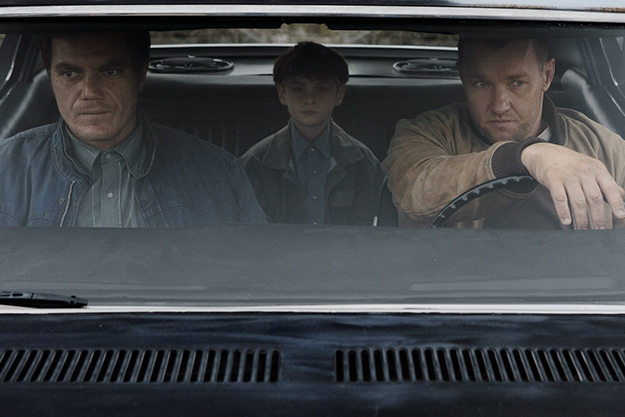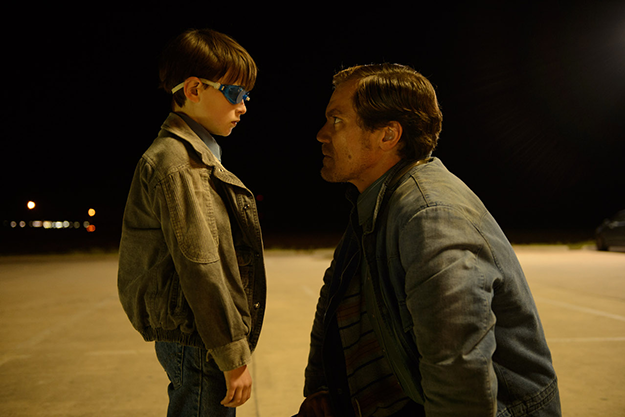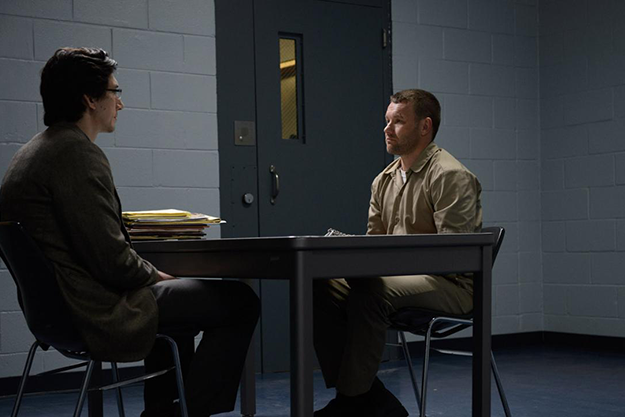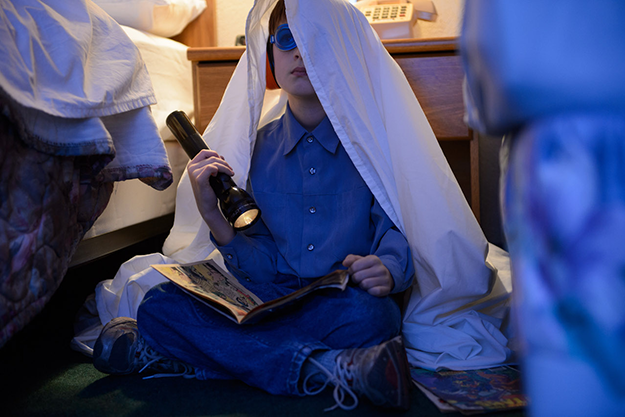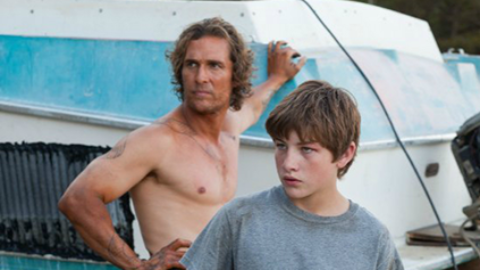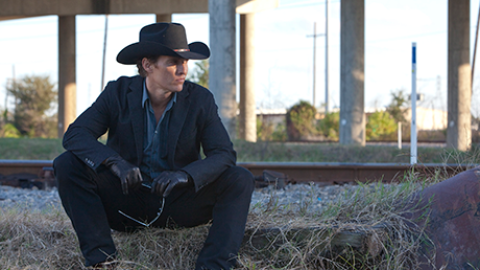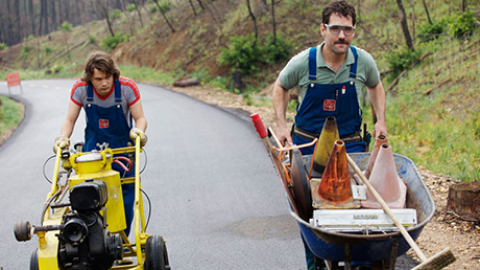Film of the Week: Midnight Special
Cinema has rarely felt so much like a son et lumière as it did in a brief period in the early ’80s, when suddenly shafts of light came shooting out of movie images, as if the screen had been slashed. It became a defining image of Steven Spielberg’s films—Close Encounters, E.T., and Poltergeist too, if you want to count that as one of his—as well as others that I can think of, including Blade Runner. It was especially a visual motif of science fiction, and in particular of that strain of science fiction that began to be discussed at the time as the “cinema of wonder” (though you can no doubt find it in thrillers of the period, and its prevalence may have something to do with the early-’80s mode for Venetian blinds as the last word in chic movie-set décor).
In their purest and most glaring form, those shafts of light had something of the quality of angelic revelation about them. Certainly, you suspected that cinematographers such as Vilmos Zsigmond and Allen Daviau had taken a close look at certain academic religious paintings of the 19th century, or perhaps at Renaissance church sculpture, with their sheaves of marble emulating beams from the divine. At any rate, it came as a shock to get the impression from these films—and with such eye-searing intensity—that cinema was a matter of light streaming directly out of the screen, rather than just bounced off it. The motif was a powerful way of restoring, if not a holy, at least an authentically otherworldly dimension to cinema.
It’s hard not to be reminded of that brief phase of intensified illumination—to use the word in more than one sense—when watching Jeff Nichols’s Midnight Special, a film which has a more persuasive claim to reviving the “cinema of wonder” than any number of bombastic CGI spectacles seen over the last couple of decades. It’s a film that’s very much about light, and about dark, as its title suggests. You could almost say that, more than anything else, Nichols’s film is about the pleasure of watching bright lights streaming through darkness—and you might not find a better definition of the pleasures of cinema, in its time-honored form.
I saw Midnight Special last month, a day or two after its first press screening at the Berlin Film Festival—by which time several colleagues had told me not to bother seeing it, because it was a preposterous film, or a noble effort that just didn’t work, or they just didn’t see the point. I have to say I loved the film and admired its audacity, but I can see why some people resisted it. It’s partly because it crosses genre boundaries with a brazen sense of freedom, starting out as one thing, apparently, before becoming something so radically different that you gasp at its flouting of state-line regulations. Partly too, it’s because Midnight Special finally pushes its sense of the otherworldly with such exalted brio that you can barely believe Nichols went all the way with it (even given the similarly audacious apocalyptic twisteroo that capped his 2011 film Take Shelter).
But maybe I’ve already given too much away, so it’s time for a spoiler alert—which ought really come in a vibrant shade of cerulean, the particular blue that is Midnight Special’s visual signature. Suffice to say that the film starts with a simple setup: we’re in a Texas motel, and two men are holed up in a room with an 8-year-old boy. We learn from the TV that the boy has been abducted, and that one of the men is named Roy Tomlin; he’s played by Nichols regular Michael Shannon, while the other, Lucas, is Joel Edgerton. They both look like pretty hardened characters, but they seem pretty gentle and solicitous towards the kid, Alton (the arrestingly solemn, self-contained Jaeden Lieberher). But why is the room entirely blacked out, and why does the boy read his Superman comics by flashlight under a blanket while wearing blue-tinted swimming goggles?
While the fugitive trio hit the Texas roads by night, there’s also mysterious business going on at a ranch, inhabited by some sort of Christian cult and overseen by somber patriarch Calvin Meyer (Sam Shepard), who gives one of his minions (Bill Camp) four days to find the abducted boy. But why does Meyer’s congregation recite seemingly random chains of numbers?
An elegant setup, which very soon cuts concisely to the chase—at least, to a lot of nocturnal road action and hidings-out—reveals that Roy is a former member of the Ranch, and the father of Alton, who turns out to have some unusual talents and disabilities. The kid can’t be exposed to light, which makes him ill, hence the goggles and the cardboard sheets for blackout blinds. He also has a strange habit of shooting bright blue beams of light from his eyes; can channel Mexican radio broadcasts straight from the airwaves (in the film’s funniest moment); and can disable satellites passing overhead (in its first big coup de cinéma). Alton has plucked those numbers and other phrases out of the air, from transmissions of classified data, which is why both the FBI and Shepard’s Rapture-seekers are after him. According to Meyer, the coded phrases and number combinations spoken by Alton are “the words of the Lord”—“Or the federal government,” retorts the FBI man facing him down. At which point Meyer leans back and coolly says: “You have no idea what you’re dealing with, do you?”
It’s a measure of the film’s chutzpah that it can get away with such a hackneyed line, because we genuinely don’t know at this stage what we’re dealing with in Midnight Special. Effectively this is a road thriller that turns gradually into a science-fiction story: it first becomes properly Spielbergian when Adam Driver turns up as studious, fascinated NSA agent Paul Sevier, essentially in the role of the impassioned, ready-to-believe boffin played by François Truffaut in Close Encounters. And it’s Driver’s Sevier, with his wide-eyed fascination and jaw slightly slack with bafflement, who comes to play the ordinary mortal we identify with as the story continues. Arguably he’s the most approachably human character here, rather than Shannon’s Tomlin or even Kirsten Dunst as the boy’s mother Sarah, also a refugee from the Ranch.
Why? Because Sevier essentially plays all three Wise Men in a story that’s easily read as a veiled Christian allegory. Alton quickly emerges as a Jesus figure—he must be, right, because he’s identified with Superman in the comic he’s reading. The protective adults around him—his parents and Lucas—are helping him get to his appointment with destiny, or the divine. For Alton is—as the poster tag-line reveals up front—“not like us,” and although seemingly the biological child of Sarah and Roy, he’s not really of this world either. This child, who becomes wiser and more melancholy as the film goes on, eventually evokes a “world built on top of ours”—which sounds like a traditional definition of heaven. So Sarah and Roy aren’t quite ordinary humans, for she is effectively the film’s Virgin Mary (a role the wholesome-cheeked Dunst was surely born for: you can imagine her in a Pietà of the prairies) and Roy its Joseph. Which would, I suppose, make honest, dependable, lunkish Lucas the donkey in the manger—a role that Edgerton plays with good grace and considerable charm.
You don’t have to get too theological about Midnight Special, although a quick Google reveals that Nichols’s films have elicited considerable interest from Christian critics. It certainly makes as much sense—although perhaps it’s not as much fun—to read Midnight Special simply as a variant on the old alien-in-peril premise (it’s also been compared to John Carpenter’s Starman) or as a close relation to certain superhero tropes. After all, the weird thing that Alton does makes him essentially the X-Men’s Cyclops, but with a metaphysical spin (it’s surely no accident that the kid, at one point isolated in a white room just like Magneto in his plastic cell, is questioned by a man whose name sounds rather like Xavier).
Deep levels notwithstanding—of course, you won’t think they’re that deep if you’re inclined to dismiss the film as mere Shyamalanic flummery—Midnight Special is rich in pleasures of a definite rough-edged funkiness. Shot in ’Scope by Nichols’s regular DP Adam Stone, the film acutely catches the drabness of Texan back roads and the grubbiness of cheap wood on motel room walls; in this sense, it has more of a ’70s feel than any kind of ’80s Spielbergian glossiness. And Nichols makes a fabulous casting choice in Bill Camp as Meyer’s emissary Doak: Camp, recently so memorable as Murry Wilson in Love & Mercy, is one of those American character actors of the sort that were once Hollywood’s bread and butter. His Doak is at once scared, weary, and faintly repellent; it helps that Camp’s face has a jowly weight faintly reminiscent of Arthur Kennedy gone to seed. There’s a wonderful moment when, sent out with a shotgun by Shepard, supposedly to do God’s bidding, he ruefully comments: “I’m an electrician, certified in two states—what do I know about these things?”
Like the films that cemented Spielberg’s prestige, and briefly supplied Shyamalan with his, Midnight Special is what you might call a “signs and wonders” movie. But it’s also a rivetingly smart and levelheaded piece of adventure storytelling, executed with expert tautness. As witness the fact that, even when Nichols unveils his climactic visual revelation—and you’ll either gasp or choke on your popcorn with incredulity—he still keeps the highway action pumping away, till the last spark has shot off the last wheel on the car. It’s some feat: keeping us suspended between miracle and macadam. And when it comes to Texan intimations of the Ineffable Sublime, it’s a hell of a lot more fun than The Tree of Life.
Jonathan Romney is a contributing editor to FILM COMMENT and writes its Film of the Week column. He is a member of the London Film Critics Circle.



